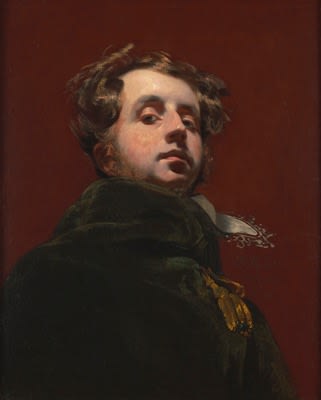
Henry Wyatt
Self-Portrait, 1826
Oil on board
25 x 20 1/8 inches (63.5 x 51.1 cm)
Philip Mould & Co.
To view all current artworks for sale visit philipmould.com This recently discovered work is one of the most engaging self-portraits painted by a British artist in the 19th Century....
To view all current artworks for sale visit philipmould.com
This recently discovered work is one of the most engaging self-portraits painted by a British artist in the 19th Century. Dated 1826, it shows a young and confident Henry Wyatt, then building a reputation as one of the best portraitists in the England. The pose is daringly unconventional, and the fact that it is painted on board, rather than a more expensive panel or canvas support, suggests that it was perhaps conceived not as a formal self-portrait, but as a private exercise. Self-portraits invariably show artists at their technical best, for without the distractions of a client, their particular needs, and contemporary fashions, and artist can focus on (or even indulge in) a pure display of their skill.
Henry Wyatt was born (in Lichfield) into the Wyatt architectural family, but the death of his father, Joseph, at the age of three meant that he was brought up by his uncle, the glass-painter Francis Eginton. Encouraged by his uncle’s trade, Wyatt sought admission to the Royal Academy schools in 1812, and by 1815 he had entered the studio of none other than Thomas Lawrence, then unquestionably the pre-eminent portraitist of the age. Wyatt became such a valued assistant to Lawrence that he was soon offered the considerable salary of £300 a year, and was responsible for some of the best studio copies of Lawrence’s work, including the portrait of the Duke of York now at Apsley House in London.
In 1817, however, Wyatt decided to establish himself as an independent artist. He practised successfully in Birmingham until 1819, then Liverpool and Manchester until 1825. He then returned to London at about the time he painted the present self-portrait, and took up residence in Newman Street, from where he was a regular exhibitor at the Royal Academy with portraits of eminent sitters such as the Archbishop of Dublin. His strong use of colour, as seen here, made him a popular artist, with the critic Samuel Redgrave writing that he was ‘a clever painter, his colour good, and his subjects pleasingly treated’. Sadly, Wyatt’s promising career was cut short by ill health; severe asthma caused him to leave London in 1834, and he died near Manchester in 1840. Two of his best known works today are subject pictures, Vigilance and Archimedes, both in the Tate collection
This recently discovered work is one of the most engaging self-portraits painted by a British artist in the 19th Century. Dated 1826, it shows a young and confident Henry Wyatt, then building a reputation as one of the best portraitists in the England. The pose is daringly unconventional, and the fact that it is painted on board, rather than a more expensive panel or canvas support, suggests that it was perhaps conceived not as a formal self-portrait, but as a private exercise. Self-portraits invariably show artists at their technical best, for without the distractions of a client, their particular needs, and contemporary fashions, and artist can focus on (or even indulge in) a pure display of their skill.
Henry Wyatt was born (in Lichfield) into the Wyatt architectural family, but the death of his father, Joseph, at the age of three meant that he was brought up by his uncle, the glass-painter Francis Eginton. Encouraged by his uncle’s trade, Wyatt sought admission to the Royal Academy schools in 1812, and by 1815 he had entered the studio of none other than Thomas Lawrence, then unquestionably the pre-eminent portraitist of the age. Wyatt became such a valued assistant to Lawrence that he was soon offered the considerable salary of £300 a year, and was responsible for some of the best studio copies of Lawrence’s work, including the portrait of the Duke of York now at Apsley House in London.
In 1817, however, Wyatt decided to establish himself as an independent artist. He practised successfully in Birmingham until 1819, then Liverpool and Manchester until 1825. He then returned to London at about the time he painted the present self-portrait, and took up residence in Newman Street, from where he was a regular exhibitor at the Royal Academy with portraits of eminent sitters such as the Archbishop of Dublin. His strong use of colour, as seen here, made him a popular artist, with the critic Samuel Redgrave writing that he was ‘a clever painter, his colour good, and his subjects pleasingly treated’. Sadly, Wyatt’s promising career was cut short by ill health; severe asthma caused him to leave London in 1834, and he died near Manchester in 1840. Two of his best known works today are subject pictures, Vigilance and Archimedes, both in the Tate collection
Provenance
Anonymous sale, Sotheby Parke Bernet, New York, September 19, 1973, lot 151;US Private Collection;
Anonymous sale, Sotheby’s New York, 2nd February 2013, as ‘Attributed to Henry Wyatt, Portrait of a Young Man’.
Be the first to hear about our available artworks
* denotes required fields
We will process the personal data you have supplied in accordance with our privacy policy (available on request). You can unsubscribe or change your preferences at any time by clicking the link in our emails.